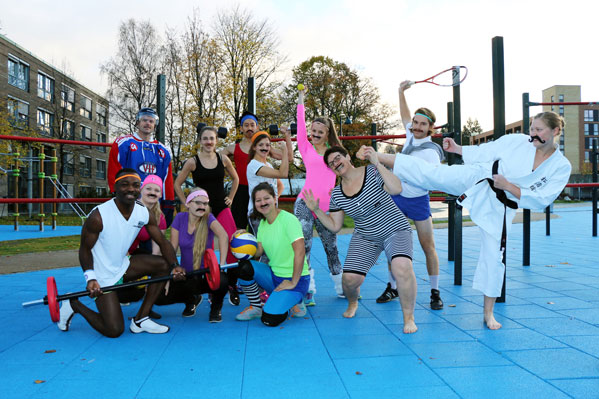Bloggers: Researcher Debbie Hill og PhD Candidate Leslie Euceda Wood
MR Cancer group, Department for ciruclation and medical imaging
It’s that time of year again! And this year, the Movember Foundation is challenging YOU to move every day this month to tackle physical inactivity. In keeping with the Movember spirit, the MR Cancer group (and friends!) donned their best training gear, and ventured out into the crisp breeze of a lovely November morning. Not only to raise a few smiles, but also to raise awareness for men’s health and prostate cancer.
According to the Movember Foundation a lack of physical activity is the fourth leading risk factor for global mortality, causing 3.2 million deaths worldwide per year. There is a push to combat physical inactivity by:
- Getting people moving (check out the MOVE campaign)
- Raising awareness on the dangers of physical inactivity & benefits of activity for both physical and mental health
- Finding new ways to encourage physical activity
- Investing in projects that increase understanding of what motivates men to move.
Here at NTNU, the CERG group are focussed on investigating the effects of exercise in medicine (check out their website for information & fitness calculators!), and recent studies have uncovered that exercising just 1.5 hours per week can reduce mortality rates by 20%.
However, it’s not necessarily that simple – despite an increase in the amount we exercise, we are actually getting fatter! This could be explained by the prolonged periods of inactivity, which is commonplace in many lines of work. Making small changes to the daily routine, like cycling to work, using the stairs rather than lifts, or encouraging a ‘walking meeting’ rather than sitting at a desk, could all make a significant difference to your general health.
At the MR cancer group we are dedicated to improving our understanding of prostate cancer and to optimise imaging strategies to determine the best course of treatment. Exercise has been shown to decrease blood serum levels of metabolic and sex hormones thought to stimulate prostate cancer (1-3).
In addition, the incidence of prostate cancer increases with age. A build up of reactive oxygen species (free radicals) can alter the conditions inside cells, and has been linked with an increase in cancer incidence. Exercise combats these changes by decreasing the amount of reactive oxygen species, and could therefore contribute to reducing cancer risk (4). In prostate cancer patients, physical activity has been associated with reduced mortality, be it prostate-specific or not. While more vigorous physical training, like biking, jogging, or swimming around three hours per week may substantially improve prostate-specific survival (5,6).
We are currently carrying out a preliminary study into the effects of exercise on prostate cancer using a prostate cancer mouse model. (See our previous blog post: How moustaches, mice and magnets contribute to prostate cancer research.) We are interested in seeing whether mice that are allowed voluntary access to exercise wheels will develop cancer in a different way (or at all!) than their non-exercising counterparts. The mouse prostates are monitored periodically using magnetic resonance imaging (MRI), and we will validate our findings with metabolic and microscopic characterisations of the tissues, such as high resolution (HR) magic angle spinning (MAS) spectroscopy and immunohistochemistry.
Our research is ultimately directed towards improving clinical practice to help with our ongoing fight against cancer, and has been made possible by funding support from the Norwegian Cancer Society, Research Council of Norway, and the Liaison Committee between Central Norway RHA and NTNU.
So, join the Movember movement whether it’s by showing off that moustache, getting more active, or both. Raise funds and awareness for men’s health, and look after your own in the process!
References
- Barnard RJ, Leung PS, Aronson WJ et al: A mechanism to explain how regular exercise might reduce the risk for clinical prostate cancer. Eur J Cancer Prev 2007; 16: 415.
- Leung PS, Aronson WJ, Ngo TH et al: Exercise alters the IGF axis in vivo and increases p53 protein in prostate tumor cells in vitro. J Appl Physiol 2004; 96: 450.
- Ornish D, Weidner G, Fair WR et al: Inten- sive lifestyle changes may affect the progres- sion of prostate cancer. J Urol 2005; 174: 1065.
- Ji LL, Gomez-Cabrera MC and Vina J: Exercise and hormesis: activation of cellular antioxidant signaling pathway. Ann N Y Acad Sci 2006; 1067: 425.
- Kenfeld SA, Stampfer MJ, Giovanucci E, Chan JM: Physical Activity and Survival After Prostate Cancer Diagnosis in the Health Professionals Follow-Up Study. J Clin Oncol 2011; 29:726-732
- Bonn SE, Sjölander A, Lagerros YT, Wiklund F, Stattin P, Holmberg E, Grönberg H, Bälter K: Physical Activity and Survival among Men Diagnosed with Prostate Cancer. Cancer Epidemiol Biomarkers Prev 2014; 24(1): 57–64

